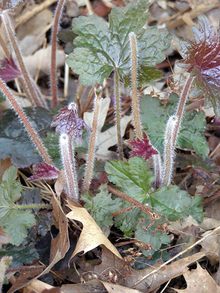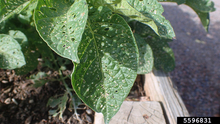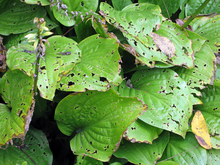As transplants go into gardens and seeds germinate, a common question right now is “what do I do about holes in plant leaves?”
You might assume that every hole is a sign of a garden-destroying insect that needs to be dealt with right away. While it could be, the only way to know for sure is to brush up on plant detective skills to serve you all summer long.
First, get curious
To answer the question of “what do I do?” you have to first answer the question “what is actually happening?” Some key things to think through are:
- What kind of plant are you looking at?
- How many plants are showing damage?
- What is your garden environment like?
- What are you actually seeing? A few big holes? Many small holes? Brown spots? Missing stems?
Bring the problem into perspective to help you figure out what info you have and what info you need. Is this something garden-wide that needs immediate attention, or is this a minor issue on one plant?
Getting curious can mean getting dirty
After you've determined if you are seeing the issue everywhere or just in one plant, get close to your plants.
The quickest way to get an answer to “what made the hole in the leaf?” might come from flipping the leaf over. Check out the base of the plant for bugs and flip over leaves to look for actively feeding bugs.
Look closely at damaged areas: are the holes fresh or do the borders look scabbed over? Again, all this info can help you make the right diagnosis and the right management decision.
Sometimes, you have to put a pin in it
While damaged plants can feel like an emergency that needs action right away, after some observation and research, it might turn out that the issue is minor, or that action is only justified if more damage occurs. Taking extra time can also be helpful in narrowing in on what exactly is going on.
Looking at the issue over time gives you a greater chance of seeing the culprit in action (be it a caterpillar that is active after dark or a rabbit that hops out from under the porch when it thinks no one is around).
Keep an eye on plants over time, and take mental notes.
- Is feeding getting worse, or is the original hole you noticed just all there is?
- Is the issue confined to one plant or one species, or is it spreading?
Common, early season feeders
Figuring out what is actually going on involves putting together all the clues you’ve collected. Cross reference with the type of holes you are seeing with what plants are being damaged.
The time of year and type of spring we are having makes some culprits more likely than others.
If you're feeding across many species of plants, but all those plants are in shady areas or planted into mulch (be it straw or wood), check for slugs. Slugs like dark, damp spots with lots of decaying plant material. See Slugs in home gardens for more information on how to deal with this pest.
If you are seeing numerous small, circular holes in recently planted vegetables, look out for small, shiny flea beetles. We have more information on flea beetles.
Sometimes, the mystery remains
Maybe the feeding doesn’t match what you find online. If you aren’t seeing more holes, don’t sweat it. Sometimes plants get damaged, be it by a passing insect, wind or hail.
If it looks like the damage isn’t spreading, just let the plants keep growing and keep an eye out for future issues.
Being observant and asking questions will help you solve your gardening issues all summer long.





